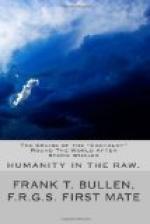The ship was some three or four miles off to leeward, so we reckoned she would take at least an hour and a half to work up to us. Meanwhile, our part of the performance being over, and well over, we thoroughly enjoyed ourselves, lazily rocking on the gentle swell by the side of a catch worth at least L800. During the conflict I had not noticed what now claimed attention— several great masses of white, semi-transparent-looking substance floating about, of huge size and irregular shape. But one of these curious lumps came floating by as we lay, tugged at by several fish, and I immediately asked the mate if he could tell me what it was and where it came from. He told me that, when dying, the cachalot always ejected the contents of his stomach, which were invariably composed of such masses as we saw before us; that he believed the stuff to be portions of big cuttle-fish, bitten off by the whale for the purpose of swallowing, but he wasn’t sure. Anyhow, I could haul this piece alongside now, if I liked, and see. Secretly wondering at the indifference shown by this officer of forty years’ whaling experience to such a wonderful fact as appeared to be here presented, I thanked him, and, sticking the boat-hook into the lump, drew it alongside. It was at once evident that it was a massive fragment of cuttle-fish—tentacle or arm—as thick as a stout man’s body, and with six or seven sucking-discs or ACETABULA on it. These were about as large as a saucer, and on their inner edge were thickly set with hooks or claws all round the rim, sharp as needles, and almost the shape and size of a tiger’s.




